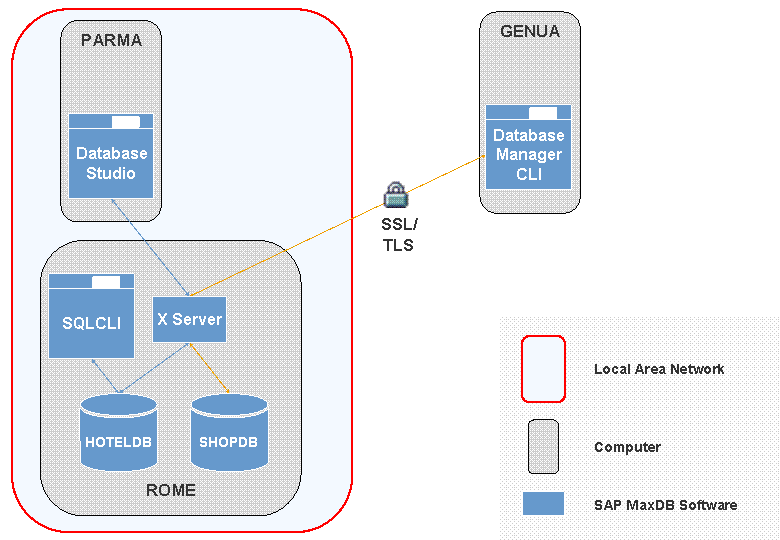 Network Communication
Network Communication 
To establish a connection to a database on a remote computer, applications (via interfaces) and database tools use the SAP MaxDB X Server (communication server) running on the remote computer. Even if more than one database is running on a computer, you only need one X Server.
More information: X Server documentation
From |
To |
Description |
|---|---|---|
SAP MaxDB X Server |
SAP MaxDB client (database tool, application with interface) |
TCP/IP optional: SSL (only in SAP systems) |
SAP MaxDB X Server |
SAProuter |
NI (SAP protocol) optional: NISSL (only in SAP systems) |
Service |
Port |
Log |
Protocol Identifier |
|---|---|---|---|
SAP MaxDB X Server |
7210 |
TCP/IP |
remote:// |
Only in SAP systems: SAP MaxDB X Server with SAP network protocol NI |
7269 |
NI (based on TCP/IP) |
sapni:// |
Only in SAP systems: SAP MaxDB X Server with SAP encryption library and SAP network protocol NI |
7270 |
SSL/TLS NISSL (based on TCP/IP) |
remotes:// sapnis:// |
To encrypt the data transfer between the client and the X Server, SAP customers can use SSL/TLS.
More information: Database Administration, Encryption
Connections to databases on the local computer use shared memory. If you want to force the database system to establish the connection via the X Server, specify localhost as the database computer when logging on to the database. Note that the JDBC interface needs the X Server even if it is installed on the same computer as the database.
Example
The HOTELDB and SHOPDB databases are both located on the ROME computer.
A user uses Database Studio on the PARMA computer and the X Server on the ROME computer to access the HOTELDB database on the ROME computer.
A second user, on the GENUA computer, uses Database Manager CLI to access the SHOPDB database by means of the same X Server on the ROME computer.
A third, local, user uses SQLCLI to access the HOTELDB database without using the X Server.

Communication Between Clients and Database in the Network (Example)